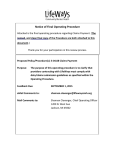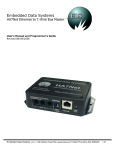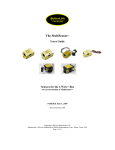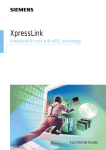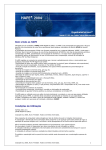Download here - Homechip
Transcript
1-Wire™ experts delivering superior sensor networks SmartSlave™ Wall-TH User Manual v1.0 Presented by: iButtonLink LLC June 27, 2013 iButtonLink LLC N8921 Stone School Road East Troy, WI 53120 USA Phone: 262-662-4029 [email protected] Fax: 262-436-2403 Description The SmartSlave™-Wall-TH is a 1-Wire™ sensor housing a humidity and temperature sensor. The SmartSlave™-Wall-TH contains the electronics to interface the sensor to a 1-Wire™ network for communication to a 1-Wire™ master device. iButtonLink SmartSlave™ devices have a family code of 0xFE. In addition, the high twelve bits of the 1-Wire™ address contain a 0x002 specifying that this slave is produced by iButtonLink LLC. SmartSlave™’s produced by iButtonLink have a serial number of the form: CC002xxxxxxxxxFE, where CC is the CRC8 of the next 7 bytes, 002 is the manufacturer code assigned to iButtonLink LLC by Maxim Integrated Products, Inc. and 0xFE is the family code indicating that the slave is NOT produced by Maxim Integrated Products, Inc.. xxxxxxxxx (36 bits) is the unique serial number for all SmartSlave™ produced by iButtonLink. It is impossible to infer the functionally of a SmartSlave™ from the family code or manufacturer ID. A Read Memory (0xF000) command should be issued to acquire the slave characteristics byte and software version number (always the 1stand 2nd by of the first memory page). SmartSlave™-Wall-TH Family Code and Identification All iButtonLink Smart Slaves™ have a family code of 0xFE which designates that this slave is not made by Maxim Integrated Products, Inc. In addition, the high twelve bits of the 1-Wire™ address contain a 0x002 specifying that this slave is produced by iButtonLink, LLC. An iButtonLink SmartSlave™ has a serial number of the form: CC002xxxxxxxxxFE, where CC is the CRC8 of the next 7 bytes, 002 is the manufacturer code assigned to iButtonLink LLC by Maxim Integrated Products, Inc. and 0xFE is the family code indicating that the slave is NOT produced by Maxim Integrated Products, Inc. xxxxxxxxx (36 bits) is the unique serial number for a SmartSlave™ produced by iButtonLink. Each SmartSlave™-Wall-TH has a unique serial number. The family code and serial number determine that the slave is made by iButtonLink, LLC. However, there is no information in the serial number that indicates this sensor is a Humidity/Temperature sensor. To determine the type of iButtonLink, LLC. SmartSlave™ the master should issue a Read Memory (0xF000) command as shown in the examples below. The first and second byte of the first memory page indicate the slave type and software version number. The first byte, byte zero, will contain a 1 if the SmartSlave™ is a SmartSlave™-WallTH slave. The second byte, byte one, will contain the software version number, which is currently a 0X10 for the first version of the code. Smart Slave Wall-TH User Manual V1.0.Docx iButtonLink Confidential Page 2 of 12 1-Wire Hardware Configuration The SmartSlave™-Wall-TH interfaces via 1-Wire™ using three 20ga. wires connected to 1-Wire™ bus +, -, and 5V signals with wire nuts. The SmartSlave™-Wall-TH requires 5 volt power for normal operation. Programming the 1-Wire™ System for the SmartSlave™-Wall-TH Four steps are necessary for any 1-Wire™ transaction: 1234- Initialization of the bus by a reset command. Sending a ROM Function command to select a slave. Sending a command to the slave. Receiving data from the slave, if the command generates data. This sequence of four steps must be executed twice to retrieve data from the SmartSlave™-WallTH . The first sequence will send a command to the SmartSlave™-Wall-TH to read the temperature and humidity. The second sequence will read the results from the SmartSlave™Wall-TH . There must be at least one second of delay between the two command sequences to give the SmartSlave™-Wall-TH time to read the sensor. Each step of these sequences will be detailed below with examples to follow. Initialization of the bus by a reset command All transactions on the 1-Wire™ bus begin with an initialization sequence. The initialization sequence consists of a reset pulse transmitted by the bus master followed by presence pulse(s) transmitted by the slave(s). The presence pulse lets the bus master know that the SmartSlave™Wall-TH is on the bus and is ready to operate. For iButtonLink Masters the ASCII command is “r” (reset). Smart Slave Wall-TH User Manual V1.0.Docx iButtonLink Confidential Page 3 of 12 The reset command returns one of the following possible values: Response Description P No error, and at least one slave is on the bus. N No error, no slaves are present. If a SmartSlave™-Wall-TH is expected to be present on this bus, there is a wiring issue, the master is not supplying 5V power, or the SmartSlave™-Wall-TH has failed. S Short, the 1-Wire™ bus is shorted. If this error is received the problem should be addressed by troubleshooting the cabling, and slaves on the bus. This is most likely not an issue with the SmartSlave™-Wall-TH E Undefined protocol error. This indicates that a slave did not respond properly to the reset or the master has an internal problem. If this is a consistent problem, try to power cycle the 1-Wire™ master or remove slaves from the bus until the problem is found. Sending a ROM Function command to select a particular slave or group of slaves. Once the bus master has detected a presence pulse generated by the reset command, it can issue one of the four ROM function commands. All ROM function commands are 8-bits long. The ROM command to use depends on the number of slaves on the bus and if the 1-Wire™ addresses of each slave are known. If there is exactly one slave on the bus If the SmartSlave™-Wall-TH is the only slave on the bus, a Skip ROM [CCh] function is the easiest way to address it. A Skip ROM command says that all slaves on the bus should be selected. This is only valid if there is exactly one slave on the bus. The proper command on an iButtonLink, LLC. master is as follows: bCC The “b” tells the master to enter “byte mode” where hexadecimal character pairs are sent to the 1-Wire™ bus. The master echoes the response from the bus. The response should be the same. Table 1 contains an example Skip ROM command sequence. Table 1 Example of Skip ROM command to select slave Full Command Response Send: rbCC P CC Breakdown of command as follows: Reset Byte mode The “b” will not be echoed Response to reset “r”. Slave is present. Characters entered in byte mode are echoed. Send r Receive P Send b No characters are returned in response. Smart Slave Wall-TH User Manual V1.0.Docx iButtonLink Confidential Page 4 of 12 Skip ROM Function Command Send CC Receive CC Note: Most commands entered into the master are case sensitive. It is important to match the case used in the examples exactly. If the received data returned from the link does not match the above example, then the command has not been sent to the bus properly due to noise, a slave error, a short, or other external condition. The command should be retried and if the failure continues the bus should be repaired. If there are multiple slaves on the bus and the address of the SmartSlave™-Wall-TH is known If there are multiple slaves and the address of the slave of interest is known, then a Match ROM [55h] function is the best choice. To use the Match ROM function, the 1-Wire™ address byte order must be reversed. Please see the examples below. Table 2 Example of using the Match ROM function to select a slave 1-Wire™ address to be selected as labeled 1-Wire™ address to be selected split into bytes 1-Wire™ address to be selected with bytes in reverse order 1-Wire™ address to be selected as used in master commands Full Command 100021B1000001FE Response P Breakdown of command as follows: Reset Byte mode Match ROM Function Command 10 00 21 B1 00 00 01 FE FE 01 00 00 B1 21 00 10 FE010000B1210010 Send: rb55FE010000B1210010 Response to reset “r”. Slave is present. 55FE010000B1210010 Characters entered in byte mode are echoed. Send r Receive P Send b No characters are returned in response. Send 55 Receive 55 Smart Slave Wall-TH User Manual V1.0.Docx iButtonLink Confidential Page 5 of 12 1-Wire™ address reversed Send: FE010000B1210010 Receive: FE010000B1210010 If there are multiple slaves on the bus and the address of the SmartSlave™-Wall-TH is NOT known There are two ways to get the address of a 1-Wire™ slave. They are: 1. Connect the slave to the master and issue an “F” command, for “first”, which will print out the first 1-Wire™ slave address on the bus. Type the “N” command, for next, to show the next 1-Wire™ slave address. If your slave is the only device on the bus and the master does not have an ID chip, you will get one result. If your master has an ID chip, then remove your slave and execute the same “F” and “N” command. Look at the difference and the missing ID is the one you need. 2. Note that all SmartSlave™-Wall-TH units have an ID that ends with FE. Making the SmartSlave™-Wall-TH do something – sending a device command. Now that the bus has been reset and the SmartSlave™-Wall-TH has been selected as in the previous examples, it is now time to tell the SmartSlave™-Wall-TH to do something. There are four basic functions available: 1. 2. 3. 4. tell the SmartSlave™-Wall-TH to read and convert the data from the sensor tell the SmartSlave™-Wall-TH to display the results tell the SmartSlave™-Wall-TH to turn on its LED tell the SmartSlave™-Wall-TH to turn off its LED. Tell the SmartSlave™-Wall-TH to read and convert data from the sensor To tell the slave to read the sensor, the Convert-V [B4h] command must be sent to the SmartSlave™-Wall-TH . This will cause the SmartSlave™-Wall-TH to read the values of both the temperature and humidity sensors and store the result in local RAM on the SmartSlave™Wall-TH . This process takes a little less than one second so the SmartSlave™-Wall-TH will not respond for second after this command is issued. Two examples are below. Table 3 Example of telling the SmartSlave™-Wall-TH to read the sensor using MatchROM function 1-Wire™ address to be converted as labeled 1-Wire™ address to be converted split into bytes 1-Wire™ address to be converted with bytes in reverse order 100021B1000001FE 10 00 21 B1 00 00 01 FE FE 01 00 00 B1 21 00 10 Smart Slave Wall-TH User Manual V1.0.Docx iButtonLink Confidential Page 6 of 12 1-Wire™ address to be converted as used in master commands Full Command FE010000B1210010 Response P Breakdown of command as follows: Reset Byte mode Match ROM Function Command 1-Wire™ address reversed Send Convert command Send a <CR> to end Byte mode Wait one second before additional commands. Send: rb55FE010000B1210010B4 Response to reset “r”. Slave is present. 55FE010000B1210010B4 Characters entered in byte mode are echoed. Send r Receive P Send b No characters are returned in response. Send 55 Receive 55 Send: FE010000B1210010 Receive: FE010000B1210010 Send: B4 Receive: B4 A <CR><LF> pair is returned. Table 4 Tell the SmartSlave™-Wall-TH to read the sensor if it is the only slave on the bus using SkipROM function Full Command Send: rbCCB4 Response P CCB4 Breakdown of command as follows: Reset Byte mode Match ROM Function Command Send Convert command Response to reset “r”. Slave is present. Characters entered in byte mode are echoed. Send r Receive P Send b No characters are returned in response. Send CC Receive CC Send: B4 Smart Slave Wall-TH User Manual V1.0.Docx iButtonLink Confidential Page 7 of 12 Send a <CR> to end Byte mode Wait one second before additional commands. Receive: B4 A <CR><LF> pair is returned. Tell the SmartSlave™-Wall-TH to send the data from the sensor to the master The Read Memory Page command tells the SmartSlave™-Wall-TH to return data to the master. 32 bytes of data are returned. The format of the data returned from the Read Memory Page command is listed in Table 5. Table 5 Data return format from F0 Read Memory Page command sent b55FE010000B1210010F000m Received: P Received: 55FE010000B1210010F000 041200000D9614D52B3032372E31372B3038302E39312B3034312E3636000000A513 Example String: Word 0 Byte Example 0 04 1 12 1 2 2 3 4 00 00 0D 3 5 6 96 14 7 8 9 10 11 12 13 14 15 D5 2B 30 32 36 2E 37 35 2B 4 5 6 7 Contents IBL Slave type (always 4 for the SmartSlave™-Wall-TH ) Slave software version number (two nibbles … high nibble is version number, low nibble is minor release number. The initial release of the SmartSlave™-Wall-TH contains an 0x12 (high nibble of 1, low nibble of 2) Conversion status. Must be zero for a valid conversion. Conversion status. Must be zero for a valid conversion. Binary temperature in Celsius. High byte. Conversion formula is .0078125 degrees C * (temperature high byte * 256 + temperature low byte). Negative values are in binary 2’s complement. Binary temperature in Celsius. Low byte. Binary relative humidity. High byte. Conversion formula is 0.0078125 % RH * (256 * high byte + low byte) Binary relative humidity. Low byte. Temperature in Celsius sign in ASCII Temperature in Celsius 100’s digit in ASCII Temperature in Celsius 10’s digit in ASCII Temperature in Celsius 1’s digit in ASCII Temperature in Celsius decimal point in ASCII Temperature in Celsius 0.1’s digit in ASCII Temperature in Celsius 0.01’s digit in ASCII Temperature in Fahrenheit sign in ASCII Smart Slave Wall-TH User Manual V1.0.Docx iButtonLink Confidential Page 8 of 12 8 9 10 11 12 13 14 15 16 16 17 18 19 20 21 22 23 24 25 26 27 28 29 30 31 32 33 30 37 39 2E 33 31 2B 30 33 36 2E 36 33 00 00 00 A5 13 Temperature in Fahrenheit 100’s digit in ASCII Temperature in Fahrenheit 10’s digit in ASCII Temperature in Fahrenheit 1’s digit in ASCII Temperature in Fahrenheit decimal point in ASCII Temperature in Fahrenheit 0.1’s digit in ASCII Temperature in Fahrenheit 0.01’s digit in ASCII Relative Humidity sign in ASCII Relative Humidity 100’s digit in ASCII Relative Humidity 10’s digit in ASCII Relative Humidity 1’s digit in ASCII Relative Humidity decimal point in ASCII Relative Humidity 0.1’s digit in ASCII Relative Humidity 0.01’s digit in ASCII Reserved Reserved Reserved CRC16 of preceding 32 bytes (LSB) CRC16 of preceding 32 bytes (MSB) The following two examples show a complete Read Memory Page command sequence. Table 6 Read Memory Page command example using Skip ROM Selection. Usable if only one slave on the bus. If a convert command immediately proceeded this command, wait one second. Full Command Send: rbCCF000m Response P Breakdown of command as follows: Reset Byte mode SkipROM Function Response to reset “r”. Slave is present. Characters entered in byte mode CCF000 are echoed. 0110000000C05EE7A099D50C Return data is sent from F000m 00000000000000000000000000 command. 000000000015009CC7 Send r Receive P Send b No characters are returned in response. Send CC Smart Slave Wall-TH User Manual V1.0.Docx iButtonLink Confidential Page 9 of 12 Command Send Read Memory Page command Receive CC Send: F000m Receive: F0000110000000C05EE7A099D50C00 000000000000000000000000000000000015009CC7 Send a <CR> to end Byte mode Wait one second before additional commands. A <CR><LF> pair is returned. Table 7 Read Memory Command example using Match ROM selection If a convert command immediately proceeded this command, wait one second. 1-Wire™ address to be converted as labeled 1-Wire™ address to be converted split into bytes 1-Wire™ address to be converted with bytes in reverse order 1-Wire™ address to be converted as used in master commands Full Command Response Breakdown of command as follows: Reset Byte mode Match ROM Function Command 100021B1000001FE 10 00 21 B1 00 00 01 FE FE 01 00 00 B1 21 00 10 FE010000B1210010 Send: rb55FE010000B1210010F000m Response to reset “r”. Slave is present. 55FE010000B1210010F000 Characters entered in byte mode are echoed. 0110000000C05EE7A099D50C Return data is sent from F000m 00000000000000000000000000 command. 000000000015009CC7 P Send r Receive P Send b No characters are returned in response. Send 55 Receive 55 Smart Slave Wall-TH User Manual V1.0.Docx iButtonLink Confidential Page 10 of 12 1-Wire™ address reversed Send Read Memory Page command Send: FE010000B1210010 Receive: FE010000B1210010 Send: F000m Receive: F0000110000000C05EE7A099D50C00 000000000000000000000000000000000015009CC7 Send a <CR> to end Byte mode Wait one second before additional commands. A <CR><LF> pair is returned. Tell the SmartSlave™-Wall-TH to turn its LED on or off Table 8 Tell the SmartSlave™-Wall-TH to turn its LED on if it is the only slave on the bus using SkipROM function Full Command Send: rbCCA50001 Response P CCA50001 Breakdown of command as follows: Reset Byte mode SkipROM Function Command Send LED control command Send a <CR> to end Byte mode Response to reset “r”. Slave is present. Characters entered in byte mode are echoed. Send r Receive P Send b No characters are returned in response. Send CC Receive CC Send: A50001 0001 = Turn on LED Receive: A50001 A <CR><LF> pair is returned. Table 9 Tell the SmartSlave™-Wall-TH to turn its LED off if it is the only slave on the bus using SkipROM function Full Command Send: rbCCA50000 Response P CCA50000 Smart Slave Wall-TH User Manual V1.0.Docx iButtonLink Confidential Response to reset “r”. Slave is present. Characters entered in byte mode Page 11 of 12 are echoed. Breakdown of command as follows: Reset Byte mode SkipROM Function Command Send LED control command Send a <CR> to end Byte mode Send r Receive P Send b No characters are returned in response. Send CC Receive CC Send: A50000 0000 = turn off LED Receive: A50000 A <CR><LF> pair is returned. Errata If a reset is issued in the middle of a 1-Wire transaction when the SmartSlave™-Wall-TH is selected, a presence pulse will not be issued by the SmartSlave™-Wall-TH . This will be fixed in future versions of the code. Two possible workarounds are: 1) Always have the SmartSlave™-Wall-TH on a network with another type of slave, 2) Issue the reset twice. 1-Wire is a trademark of Maxim Integrated Products, Inc. Smart Slave Wall-TH User Manual V1.0.Docx iButtonLink Confidential Page 12 of 12












